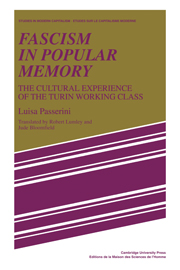Book contents
2 - Fascism and the symbolic order in everyday life
Published online by Cambridge University Press: 04 August 2010
Summary
The memory of Fascism
The memory of Fascism in our testimonies, in keeping with the fixed pattern of narrative in memories of oneself, widens the gap between the regime and the subjects, including even those who admit to having been members of the PNF and worn the insignia. Fixed identity must be matched at the narrative level, by a sharply defined ‘otherness’: Fascism is precisely ‘other’ than oneself. From this derives the juxtaposing of good and evil, life and death, the oppressed and the powerful, which takes on various forms, according to who the witnesses are. These forms are not, however, like those descriptions of the long and painful process of reaching awareness – that passage from darkness to light – to which so much of the autobiographical writing of intellectuals and the self-educated alludes. Such an outlook is also apparent from the titles: The Long Journey through Fascism, The Hard Years, The Turncoat.
The identification of Fascism with evil and a source of national shame, and the consequent desire to keep quiet about it, even among those not actually responsible, and who were powerless to act, acquiescent or passive onlookers, signifies that power makes those who are subjected to it complicit in its exercise. This involvement explains the frequent recurrence in the memoirs, and also in the historiography of the period immediately following the fall of Fascism, of a sense of shame, guilt, silence and injury.
- Type
- Chapter
- Information
- Fascism in Popular MemoryThe Cultural Experience of the Turin Working Class, pp. 67 - 126Publisher: Cambridge University PressPrint publication year: 1987



